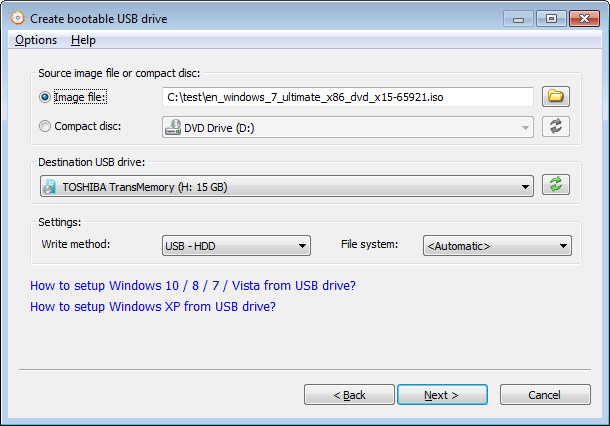
- #USB LOADER FOR WINDOWS 7 INSTALL#
- #USB LOADER FOR WINDOWS 7 FULL#
- #USB LOADER FOR WINDOWS 7 ISO#
- #USB LOADER FOR WINDOWS 7 DOWNLOAD#
- #USB LOADER FOR WINDOWS 7 FREE#
Can’t find myself on the drive I booted from If you’re using Universal-USB-Installer-2.0.0.9.exe and you still receive Insane primary (MBR) partition notices, I plan to make all of the necessary changes and then provide a fix as time allows. In addition, it must house a nf file containing the text / Union. In that Debian now requires a rename of the persistent block file and label from live-rw to persistence. Persistence feature is currently broken with Newer Debian based distributions. So make sure it remains UUI in order to allow those distributions to boot. It does attempt to automatically create this Label, but may fail. The tool expects the Volume Label of your USB drive to be UUI in order for OpenSUSE, CentOS and a few other distributions to boot.
#USB LOADER FOR WINDOWS 7 FULL#
And then finally boot into your full Portable Windows. You will need to boot using your Windows to Go flash drive a second time to finalize the setup process. When Windows boots from the USB for the first time, it will go through the setup process and then reboot. You will need a very fast solid state flash drive. Most of the flash drives found at local department stores won’t be fast enough.
#USB LOADER FOR WINDOWS 7 FREE#
The Windows to Go option does require the USB drive be NTFS formatted and have 20GB+ free space to hold the virtual disk. Universal USB Installer Troubleshooting, Issues, Bugs Feel free to contact me to submit recommendations. More Live Linux Distributions will be added as time permits.
#USB LOADER FOR WINDOWS 7 INSTALL#
Windows to Go + Install Windows from USB. USB Backtrack – USB Kali Linux (with persistence). USB Linux Mint 32/64 Bit (with persistence). USB Ubuntu 32/64 Bit (with persistence). The Universal USB Installer (UUI) might be used to make a USB Boot from the following Live Linux Portable Operating Systems, Windows Installers, System Diagnostic Flash Drive Tools, and Antivirus Utilities. USB Bootable Portable Operating Systems and Tools – Version 2.0.0.0: Recompiled the tool using the newer Nullsoft Scriptable Install System Version 3.06.1. Also removed old distros that are no longer in development. Updated to support newer Clonezilla and OpenSUSE. – Version 2.0.0.1: Fixed Zorin persistence feature. Note that devices listed as local (fixed) disks will no longer be detected. Also switched to list only removable USB media. – Version 2.0.0.2: Performed general cleanup of unused code. Implemented a checkpoint to prevent running from Operating Systems prior to Windows 8. Included a confirmation prompt before proceeding to format a drive. – Version 2.0.0.3: Set to show Local Drives in addition to USB Drives. – Version 2.0.0.3a: quick revision to disallow (Disk 0) from being displayed. Moved checkpoint to simply prevent NTFS format option from appearing on systems prior to Windows 8. – Version 2.0.4: Re-enabled the ability to run from earlier versions of Windows.
#USB LOADER FOR WINDOWS 7 DOWNLOAD#
– Version 2.0.6: Updated AmogOS with persistence download link.Ģ3 Jul, 2021 – Version 2.0.5: Updated to support AmogOS and HDClone. Updated Archbang and Archlinux to use dd rawwrite method.

– Version 2.0.7: Added Wipe option to reformat and restore a USB flash drive. – Version 2.0.8: Updated to support writable persistence for Lubuntu, Xubuntu, Kubuntu versions 20.04+. – Version 2.0.9: Fixed to allow spaces in Windows user profile. The following Changelog outlines any recent changes made to the software. Universal-USB-Installer-2.0.0.9.exe: Fixed to allow spaces in Windows user profile.
#USB LOADER FOR WINDOWS 7 ISO#
It can help you Boot Multiple ISO files from one flash drive.

NOTE: If you are wanting to add multiple Live Linux Distributions, System Diagnostic Tools, Antivirus Utilities, and Windows Installers, you should use the YUMI Multiboot USB Software, instead. A larger than 4GB casper-rw or persistent option is also possible when the USB drive is formatted with an NTFS filesystem. Ubuntu based Casper Persistence works with FAT32 or NTFS formatted drives. This Persistent feature allows you to save some changes and then restore them on subsequent boots.

Another key feature of UUI is Persistence storage, where available. However, it may be possible to Recover Lost USB flash drive space and then create an exFAT partition for continued storage purposes. The DD method of copying, also known as Data Destroyer works by overwriting the entire file system, making the USB device appear as a CD/DVD which is limited to the size of the ISO file. Unlike tools which simply use the DD (Copy and Convert) command to directly Burn ISO to USB, the Universal USB Installer includes several other methods that natively allow you to continue using your flash drive for storage purposes, whilst including a “Try via DD” option.


 0 kommentar(er)
0 kommentar(er)
